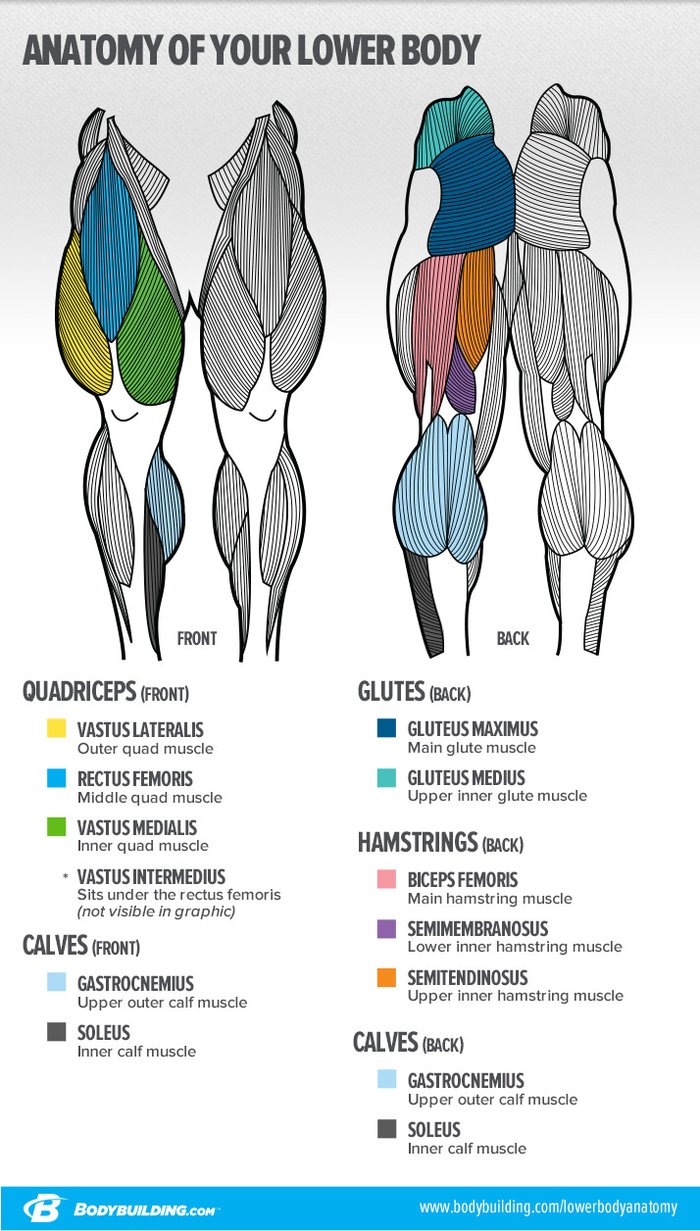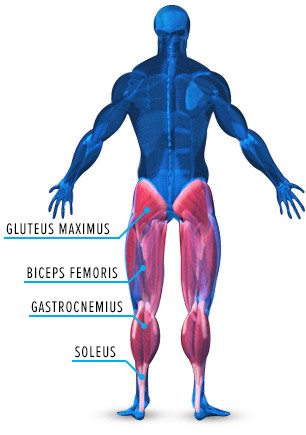Muscle Growth | Arms | Legs | Back | Chest | Shoulders | Core
Let’s be honest: You can’t build full-body size and strength without training your legs. Training legs not only helps them look great, but also gives you a strong, stable base for improved performance and additional physical power.
Plenty of people avoid leg training because it’s uncomfortable and painful. Some of that is inevitable, but some of it might be because they’re working against their anatomy! Before your next leg day, educate yourself about the essential muscular and skeletal anatomy of your legs, and the best leg exercises to help you build the strong, muscular lower body you’ve always wanted.
Muscular Anatomy of the Quadriceps
Your quads are made up of four main muscle groups—hence the prefix, ”quad.” These muscles work in concert to extend your knee, flex your hip, and power you through some of the heaviest exercises in the weight room.
Vastus Lateralis: Bodybuilders and physique athletes covet the outer thigh sweep that comes from developing your vastus lateralis, named for its location on the outside of your thigh. The muscle starts at the top of your femur (thigh bone) and attaches to the patellar tendon in your knee joint.
Vastus Medialis: That teardrop shape on your inner thigh comes from the vastus medialis. This muscle starts at the top of the femur and attaches to the patellar tendon on the inside of your leg.
Vastus Intermedius: The vastus intermedius is deep in the middle of your thigh. You can’t see it because it’s covered by the rectus femoris, but it also originates on the femur and attaches to the patellar tendon.
Rectus Femoris: This muscle is unique because it’s the only one of your quadriceps muscles that crosses your hip. It connects at the top of the pelvis and comes down all the way to insert at the patellar tendon in the knee.

Muscular Anatomy of the Hamstrings
If you want strong, defined legs, you need to spend as much time developing the back as you do the front. Healthy hamstrings don’t just look great, they contribute to both knee stability and lower back health. They also power two big-time movements: hip extension (think deadlift) and knee flexion (think leg curl).
Here’s what these powerhouse muscles are made of:
Biceps Femoris: A two-headed muscle, the long head runs from the ischial tuberosity—or the sitting bones—and attaches to the fibula. The short head originates on the back part of the femur and attaches to the fibula.
Semimembranosus: This wide, flat, and deep muscle originates at the ischial tuberosity and attaches at the tibia. It’s more medial, or closer to the midline, than the semitendinosus.
Semitendinosus: The semitendinosus runs from the ischial tuberosity and also attaches to the tibia. This muscle is notable for the length of its tendon insertion, which can be partially removed to replace a torn anterior cruciate ligament (ACL).
You don’t have to be a pre-workout connoisseur to appreciate one on leg day! Keep moving heavy weights with caffeine and other proven performance boosters in your corner.
Muscular Anatomy of the Glutes

While a nice set of glutes is a must for any physique athlete, these muscles are also hugely important for keeping your trunk upright and protecting your lower back, in addition to working alongside the hammies to extend your hips.
And they’re not just for Instagram—anyone with lifting or athletic ambitions can benefit from building stronger glutes!
Gluteus Maximus: The most visible and the largest glute muscle starts on your sacrum (the triangular bone at the base of the spine) and your lumbar fascia (connective tissue in your lower back) and attaches to your iliotibial tract, or your IT band, and your outer thigh.
Gluteus Medius: Most people aren’t concerned with this muscle because it’s deeper and you can’t see it, but the glute medius is an important stabilizer of the hip and thigh. It runs from the top of your hip bone (the iliac crest) and attaches to your outer thigh.
Gluteus Minimus: Even deeper than the glute medius is your glute minimus. It’s a very small muscle that starts on the outer portion of your hip and attaches to the outer thigh.
Feel your glutes working better in your warm-up, circuits, or any movement with resistance bands.
Muscular Anatomy of the Calves
You can’t have great legs without a good set of calves. The two main muscles in your calves are the gastrocnemius and the soleus, which both work to flex and point your foot.
Gastrocnemius: Unique because it crosses the back of the knee joint, the gastrocnemius has two heads, lateral and medial, which converge and attach to your Achilles tendon in your ankle.
Soleus: Deeper than the gastrocnemius, the soleus originates at the tibia and fibula and attaches to the Achilles tendon.
Essential Muscle-Building Leg Exercises
Want to put all of that functional anatomy into action? Here are some great exercises to target and build those leg muscles for a stronger base and a balanced physique. You’ll find all of these exercises and more in the comprehensive leg workouts in the Built by Science 6-week muscle-building trainer.
1. Front Squat
Front squats hit almost every muscle in your legs. As you sit down into the squat, you lengthen the quads and load the hamstrings, adductors, and glutes. When you stand up, you extend the knee and fire your quads. Yes, they’re brutally hard, but luckily there are plenty of ways to make them… even harder.
This exercise hammers the glutes and hamstrings and is slightly more spine-friendly for most lifters than pulling deadlifts off the floor. Keep your knees soft and your spine neutral. As you push your hips back, your glutes and hamstrings stretch out. Push through your heels and extend up, flexing your glutes.
Going heavy on RDLs? A solid leather or nylon belt can protect your back while you build your backside.
The lunge trains one leg at a time, forcing your body to stabilize and hitting every muscle in your leg. Your quads extend as you step forward and back, while your hamstrings and glutes pull you down and help you come back out of the bottom. You’ll also use those little muscles like the glute minimus and adductors to control the movement, which comes in near-endless variations.
This exercise targets the gastrocnemius, and can be loaded heavily using machines or weights, or done for high reps and with strategic pauses using body weight alone. To target the soleus, perform a seated calf raise.
Learn how to train every muscle group based on its anatomy and build your body the way you want!
